A History of the Auberge du Père Bise: Featuring an In-House Recipe
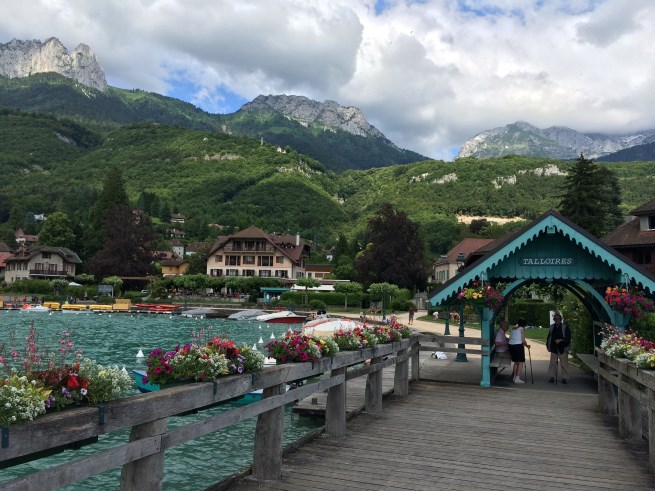
In the village of Talloires, along Lake Annecy, sits a rustic-looking inn. Originally a simple guinguette, or tavern, the Auberge du Père Bise is a prestigious hotel and restaurant. Run by the same family for four generations, the kitchen has almost always been under the command of women chefs.
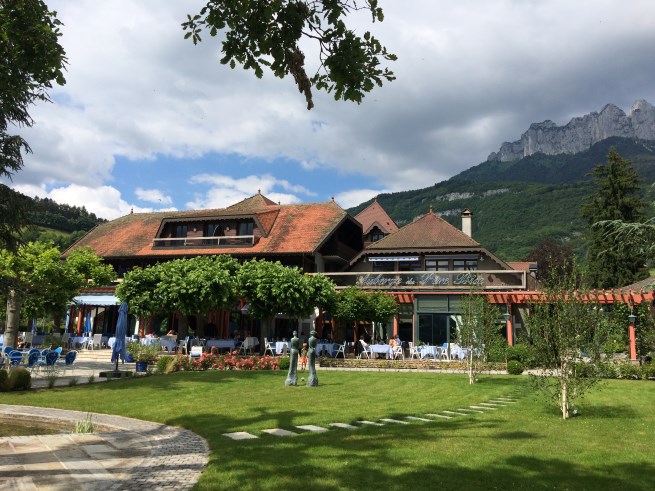
The Auberge du Père Bise in Talloires, along Lake Annecy. Photo: Allison Zinder.
During a recent stay at the Auberge, I took advantage of swimming in the pure waters of the lake and sunning on the beautifully landscaped grounds. Even better, though, was walking around the well-appointed dining room to glean a bit of the establishment’s history.
In 1903, François and Marie Bise bought a tiny chalet in Talloires. Boats carrying tourists and inspiration-seeking painters like Paul Cézanne stopped off at Talloires, and François saw the advantage of creating a guinguette there. With Marie at the helm in the kitchen, the couple quickly developed a reputation among well-heeled guests looking to taste the fresh lake Char (omble chevalier) or rabbit terrine.
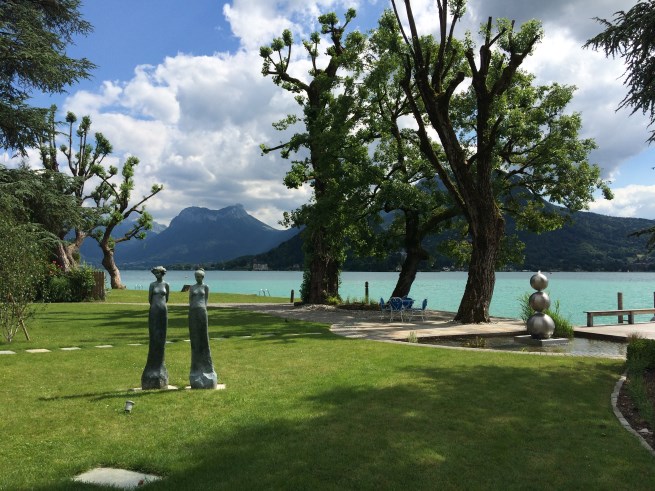
The garden and sunning area of the Auberge du Père Bise in Talloires, along Lake Annecy. Photo: Allison Zinder.
Each successive generation of the Bise family has introduced its own brand of charisma, and its own specialties, to the Auberge. Under François and Marie’s son, Marius, and his wife Marguerite, the restaurant was expanded and officially named “Auberge du Père Bise” – and was proclaimed a temple of gastronomy in 1937. In the tradition of nearby Lyon, where women chefs were called les mères lyonnaises, Chef Marguerite turned out signature dishes like crayfish gratin and fattened chicken from Bresse with tarragon.
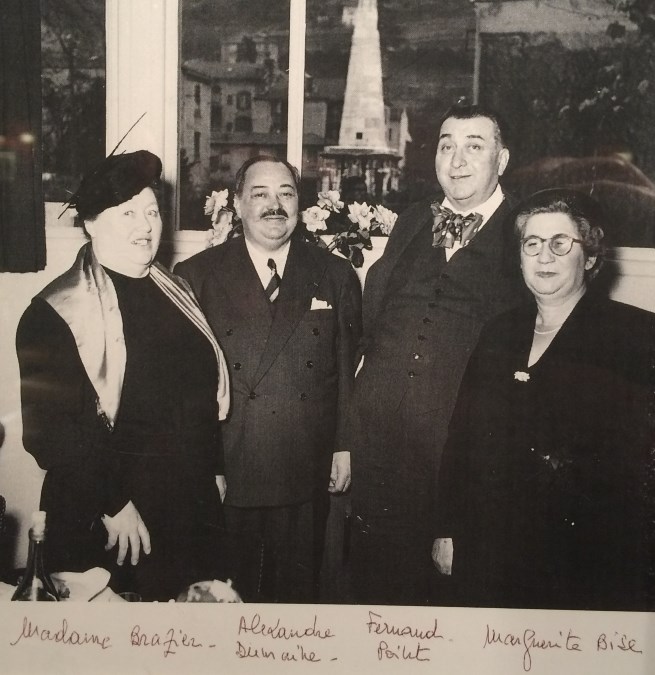
The era’s most famous chefs: Eugénie Brazier, Alexandre Dumaine, Fernand Point, and Marguerite Bise. Photo: courtesy of the Auberge du Père Bise.
Marius and Marguerite’s son, François, took over in 1965, after training with Fernand Point at the Pyramide in Vienne. With his wife Charlyne, François became an “aristocrat of French cuisine” and frequented the likes of Paul Bocuse and Alain Chapel. And by the time he passed away in 1980, his daughter Sophie was already well on her way to making sure the kitchen would be reclaimed by a woman chef.
Today a member of the prestigious Relais & Châteaux network, the Auberge du Père Bise’s restaurant has one Michelin star. Sophie Bise expresses her creativity in the kitchen, using local products, and continues not only her own family’s traditions, but also the institution of women chefs in France. In May 2017, the Auberge du Père Bise will pass out of the Bise family, and into the capable hands of Jean and Magali Sulpice. The change will certainly mark the end of an era.
Visit the Auberge du Père Bise website here.
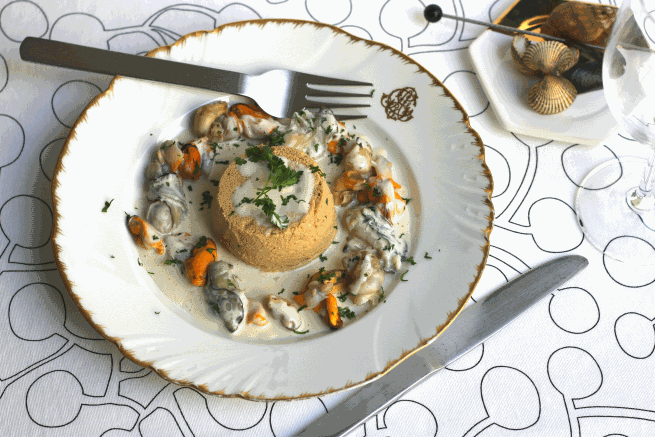
Warm Oysters and Shellfish with a Farm-fresh Chicken Liver Gâteau. Photo: Allison Zinder.
Warm Oysters and Shellfish with a Farm-fresh Chicken Liver Gâteau
Ingredients:
- 1 marrow bone, about 3×3 inches (or 7.5×7.5cm; available from a good butcher)
- generous ⅓ cup (3¼ ounces or 90g) best-quality chicken livers from organic or free-range chickens (also available from a good butcher)
- 1 clove garlic, green germ removed if necessary
- 3 eggs
- 1 egg yolk
- 1 cup (240g) milk
- 1 teaspoon fine sea salt
- ½ teaspoon white pepper
- 1 tablespoon (15g) butter, for the ramekins
For the shellfish and the sauce:
- 6 ounces (175g) cockle clams (coques)
- 7 ounces (200g) mussels
- ½ small shallot, finely diced
- ½ cup (120g) dry white wine
- 8 oysters, 3-4 ounces (86-110g) each
- 4½ ounces (125g) cooked winkles or whelks (bigorneaux or bulots)
- generous ⅓ cup (90g) heavy whipping cream
- a few pretty sprigs of chervil or other favorite herb
- chopped chervil or other favorite herb
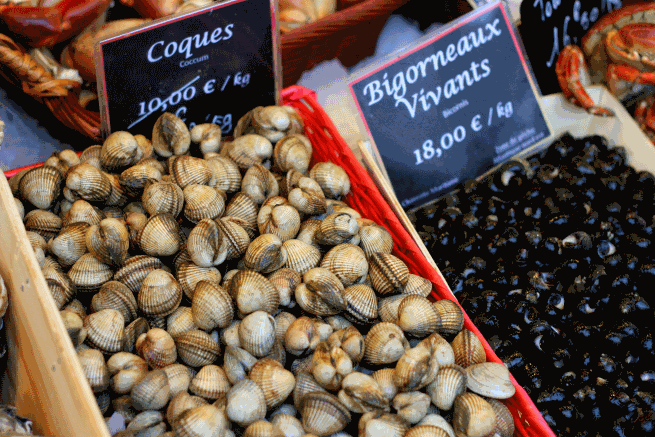
Cockles and winkles for sale at a market in the 20th district of Paris. Photo: Allison Zinder.
How to make it:
- Place the marrow bone in a medium-sized casserole. Cover it with cold water, and bring it the boil. Let it simmer for about 8 minutes, then remove and rinse with cold water. Using a small spoon, scoop out the marrow. You should have about 1 tablespoon (15g).
- In a food processor, combine the marrow, chicken livers, garlic, eggs, and egg yolk. Process for about 2 minutes, pulsing from time to time, and scraping down the sides of the bowl.
- Continue to process and add the milk in a steady stream. Add the salt and pepper. Strain the mixture through a fine-meshed strainer.
- Butter 4 ceramic ramekins (3 inches or 7.5cm in diameter) and pour the mixture evenly among them. Cover them with plastic film.
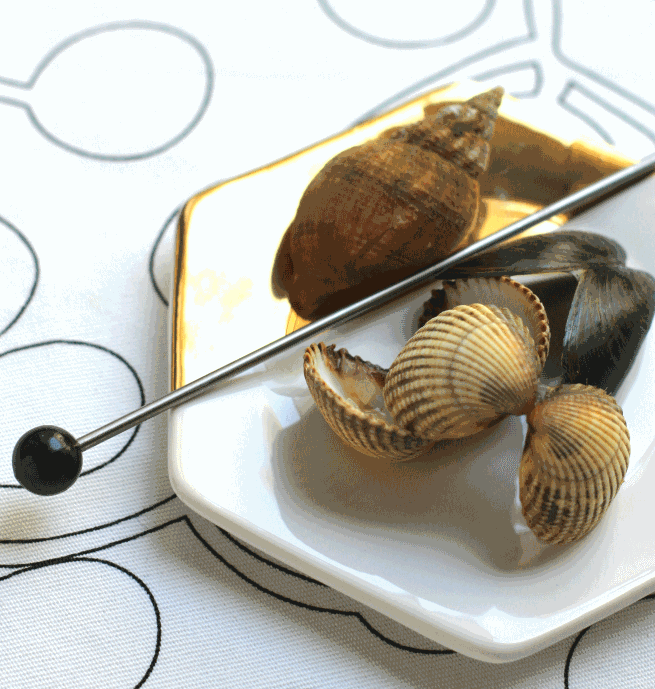
Photo: Allison Zinder
- Place the ramekins in a steamer basket inside a large casserole and steam, covered tightly, over very low heat for 20-25 minutes, or until a knife poked into the liver gâteau comes out clean. Remove the ramekins from the steamer basket and let them cool.
- Soak the cockle clams in a large bowl of cold salt water for 30 minutes, stirring them from time to time. This will help the clams release any sand or dirt. Rinse well and drain.
- De-beard and scrub the mussels. Rinse and drain.
- In a medium saucepan, combine the diced shallot and white wine. Bring to the boil, then add the cockles and cover. Lower the heat and cook just enough to open the cockles (about 2-3 minutes). Using a slotted spoon, scoop out the cockles, and bring the liquid back to the boil. Add the mussels and repeat the process as for the cockles. When the mussels are open, scoop them out with the slotted spoon, but save the cooking liquid! Strain it through a very fine-meshed strainer (or some muslin) into a small bowl.
- Shell the cockle clams and mussels (or leave just one or two unshelled if you like – they make for a pretty plate).
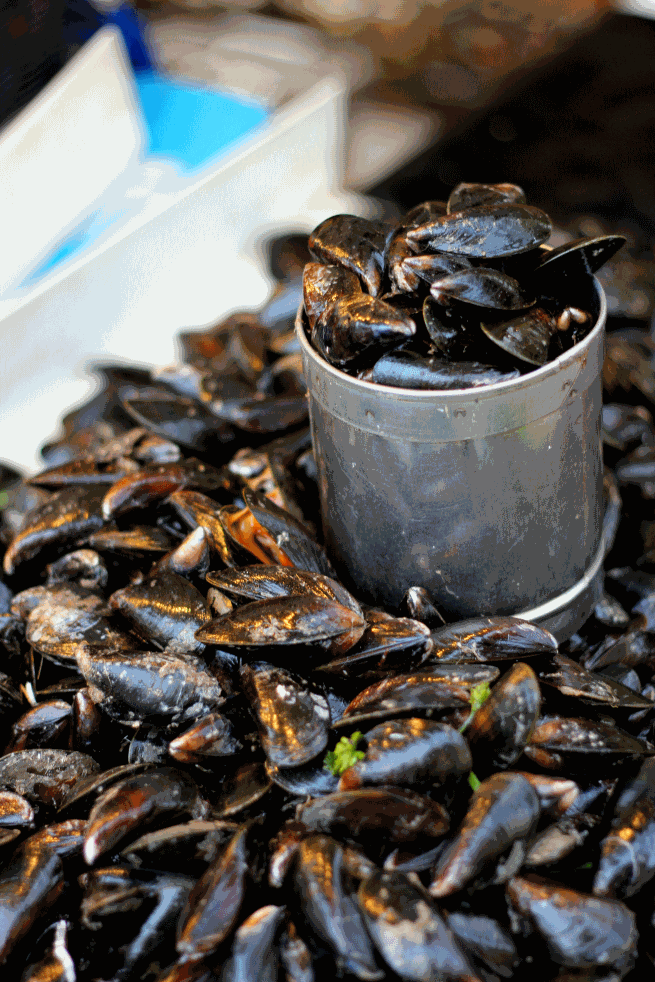
Fresh mussels for sale at a market in the 20th district of Paris. Photo: Allison Zinder
- Open the oysters, throw out the first “juice.” After a few minutes, more liquid will appear around the oysters – strain this liquid through the fine-meshed strainer with the rest of the shellfish cooking liquid. Remove the oysters entirely from their shells, quickly run them under cold water, and store in a cool place.
- Shell the cooked winkles or whelks. Preheat oven to 300°F (150°C). Unmold each liver gâteau and place it on a plate. Warm the plates with the gâteaux in the oven.
- Pour all of the shellfish cooking liquid back into the saucepan and let it reduce over medium heat for about 5 minutes. Remove from heat, add the cream, and place back on medium heat. Let the mixture reduce about ⅓ or until it becomes thick.
- Place the shellfish (except oysters) in the sauce to let them warm. Add the oysters for the last 2 minutes, then using a slotted spoon, remove the shellfish and distribute them evenly onto each plate around the gâteau.
- Bring the sauce to a last boil, whisking vigorously. Pour this sauce around the gâteau on each plate. Decorate with a sprig of chervil or other favorite herb, and sprinkle the chopped herbs over the whole plate.
- Serve with a smoky white sauvignon blanc, like Pouilly fumé. According to the Père Bise, this dish needs “a mineral tension for the oyster and for the complexity of the chicken liver.” Enjoy!
Serves 4
For more fantastic French inspired recipes, check out France Today’s curated selection.
Share to: Facebook Twitter LinkedIn Email
More in Auberge du Père Bise
Leave a reply
Your email address will not be published. Required fields are marked *



